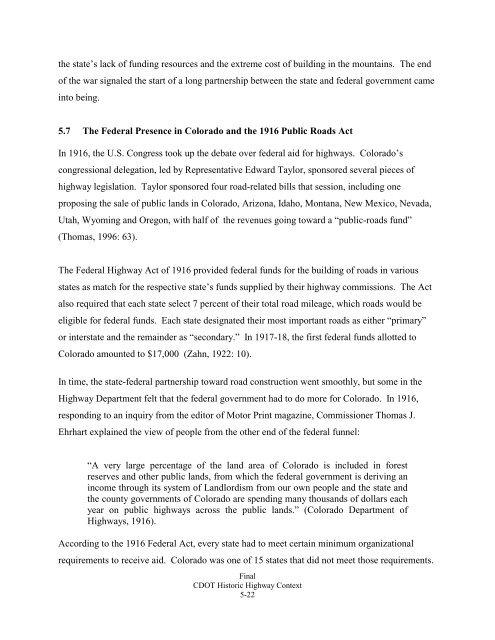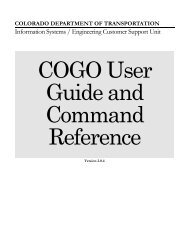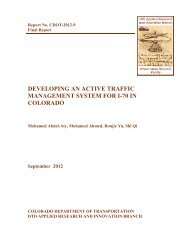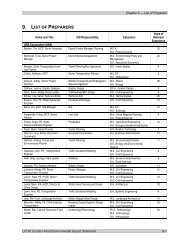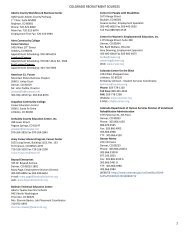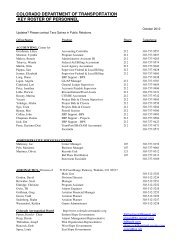Chapter 5 THE AUTOMOBILE AGE BEGINS, 1890-1930 - Colorado ...
Chapter 5 THE AUTOMOBILE AGE BEGINS, 1890-1930 - Colorado ...
Chapter 5 THE AUTOMOBILE AGE BEGINS, 1890-1930 - Colorado ...
Create successful ePaper yourself
Turn your PDF publications into a flip-book with our unique Google optimized e-Paper software.
the state’s lack of funding resources and the extreme cost of building in the mountains. The end<br />
of the war signaled the start of a long partnership between the state and federal government came<br />
into being.<br />
5.7 The Federal Presence in <strong>Colorado</strong> and the 1916 Public Roads Act<br />
In 1916, the U.S. Congress took up the debate over federal aid for highways. <strong>Colorado</strong>’s<br />
congressional delegation, led by Representative Edward Taylor, sponsored several pieces of<br />
highway legislation. Taylor sponsored four road-related bills that session, including one<br />
proposing the sale of public lands in <strong>Colorado</strong>, Arizona, Idaho, Montana, New Mexico, Nevada,<br />
Utah, Wyoming and Oregon, with half of the revenues going toward a “public-roads fund”<br />
(Thomas, 1996: 63).<br />
The Federal Highway Act of 1916 provided federal funds for the building of roads in various<br />
states as match for the respective state’s funds supplied by their highway commissions. The Act<br />
also required that each state select 7 percent of their total road mileage, which roads would be<br />
eligible for federal funds. Each state designated their most important roads as either “primary”<br />
or interstate and the remainder as “secondary.” In 1917-18, the first federal funds allotted to<br />
<strong>Colorado</strong> amounted to $17,000 (Zahn, 1922: 10).<br />
In time, the state-federal partnership toward road construction went smoothly, but some in the<br />
Highway Department felt that the federal government had to do more for <strong>Colorado</strong>. In 1916,<br />
responding to an inquiry from the editor of Motor Print magazine, Commissioner Thomas J.<br />
Ehrhart explained the view of people from the other end of the federal funnel:<br />
“A very large percentage of the land area of <strong>Colorado</strong> is included in forest<br />
reserves and other public lands, from which the federal government is deriving an<br />
income through its system of Landlordism from our own people and the state and<br />
the county governments of <strong>Colorado</strong> are spending many thousands of dollars each<br />
year on public highways across the public lands.” (<strong>Colorado</strong> Department of<br />
Highways, 1916).<br />
According to the 1916 Federal Act, every state had to meet certain minimum organizational<br />
requirements to receive aid. <strong>Colorado</strong> was one of 15 states that did not meet those requirements.<br />
Final<br />
CDOT Historic Highway Context<br />
5-22


